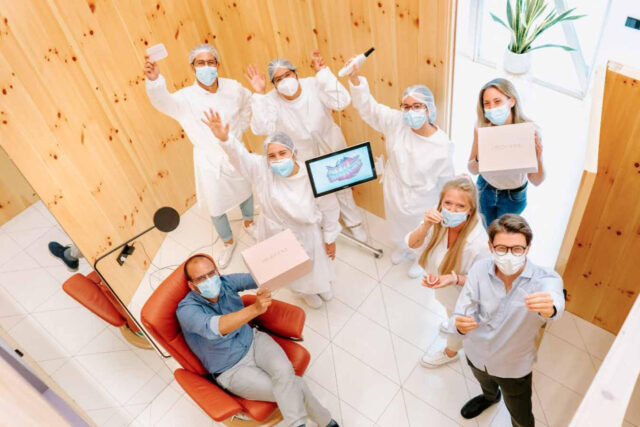
Orthodontic treatments are carried out in a clinic and are used to gradually correct the position of your teeth, with the aim of getting them into the correct position, always taking into account both the aesthetic and functional aspects.
Thanks to orthodontic treatments, problems of malocclusion, crowding, crooked, open or inverted bite, overbite, midline deviation, diastema or teeth that are born in a rotated position due to a developmental problem can be corrected. All types of orthodontics, all types of orthodontics, such as clear aligners from Smile2Impress, are based on taking advantage of the continuous regeneration of the bone and tissues of the oral cavity to modify the position of the teeth. In addition, they all require permanent revision by an orthodontist with specific training in order to achieve a completely satisfactory result.
In general terms, we can divide the orthodontics or braces available to you into 2 main categories: fixed and removable OR visible and invisible, but this article focuses on describing the types of invisible orthodontics that exist today and which have been appearing in recent years.
Types of invisible orthodontics
Lingual Orthodontics

This technique is very similar to traditional orthodontics, with the difference that the brackets are placed on the inside of the teeth and are thinner. It is capable of correcting the same problems as traditional orthodontics. However, in addition to the aesthetic fact that, being on the inside of the teeth, other people cannot see it with the naked eye, it has added advantages. One of these advantages is that dental hygiene is easier to carry out, there is no risk of damaging the dental enamel on the front of the teeth and the saliva itself carries out a continuous self-cleaning task of the appliance, while at the same time, by increasing its concentration, it also generates an increase in its antibacterial action.
Impress Clear Aligners

This is the most advanced, most studied and patented orthodontic technique. Likewise, within the types of invisible orthodontics, it is the one with the most experience at present. It is a removable treatment in which splints made of completely transparent plastic materials are used to place the teeth in the position they should occupy, which are changed every two weeks. As it is a removable treatment, the splints can be removed to eat or to brush your teeth, but they must be worn for at least 22 hours a day.
Pain is the worst fear of all patients. But the truth is that clear aligners are much less painful than brackets, although it is normal during the first few days of wearing the splints to feel a little discomfort in the teeth due to the pressure exerted by the aligners on the jaws. In the event of any discomfort, an ibuprofen can soothe it.
The duration of treatment will depend on each patient and the type of dental problem to be corrected. It also depends on whether orthodontics needs to be supplemented with other dental treatments. And, of course, it will also include how carefully or strictly the patients use the aligners. Taking all these aspects into account, between six months and a full year’s duration is typical.
As you can see, one of the benefits of this type of treatment is that the results are quicker than using other types of orthodontics. You will appreciate the changes in three or four months. As long as you follow the orthodontist’s instructions and recommendations, you are responsible. It is therefore always recommended to follow the expert’s instructions, be responsible and wear the aligners for the appropriate amount of time.

Among the main advantages reported by patients are comfort, cleanliness, quick adaptation, aesthetics… and among the biomechanical and technical advantages of the system, we can highlight the increasing precision achieved by this system, the speed and efficiency of working with the company’s software and technical equipment, the protocolisation and simplicity of the technique which allows a better and more efficient organization at a clinical level, and of course, the biological compatibility and convenience of the forces applied.
Although they are not invisible orthodontics, it is also worth mentioning Sapphire Braces, which are more concealable than metal brackets and are practically invisible. They are also similar to ceramic braces in the sense that they cause less discomfort to the wearer due to their smaller size, thus causing less chafing on the gums and inside of the lip. Sapphire, known for its hardness, prevents brackets from wearing out and makes them very resistant. With proper care, braces are unlikely to break.
Many people may wonder what type of braces they need or which one would be best for them. It is not an easy and simple task to know how to identify dental problems and orthodontics is a very specialised and specific science. The truth is that an orthodontist is the person who can best advise you on the type of orthodontics that best suits you and your needs. For this reason, it is always advisable to go to a qualified dental clinic with qualified professionals and be advised by those who understand and deal with this type of problem on a daily basis. When presenting symptoms such as misaligned teeth, very large spaces between teeth, missing teeth, worn teeth, pain in the temporomandibular joint, problems opening or closing, disharmony between the maxillary bones, facial asymmetries or strong contacts in the bite, among others, we can intuit that we need orthodontic treatment.

Choosing the type of orthodontics depends on many factors such as the initial state of the dentition or the problem(s) it presents, as well as the patient’s preferences and motivations. This is also an important issue to take into account in the diagnosis, treatment plan and personalized budget for treatment.
The options for orthodontic treatment are multiple, from the most traditional, to the new and advanced such as clear braces, both of which are very effective options. Although it may seem only a question of aesthetics, the truth is that orthodontics also has a lot to do with our health and wellbeing.






